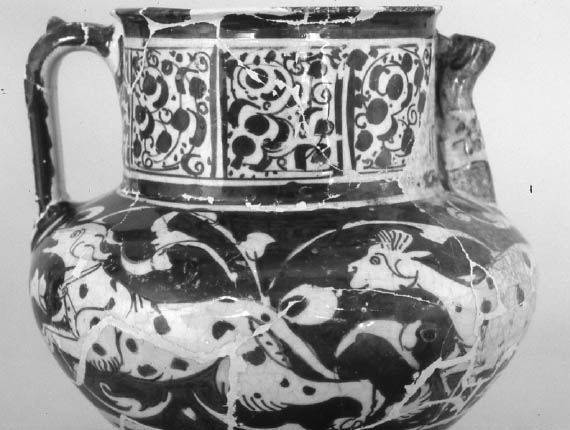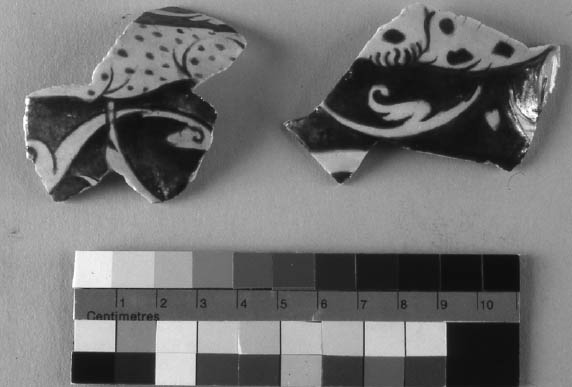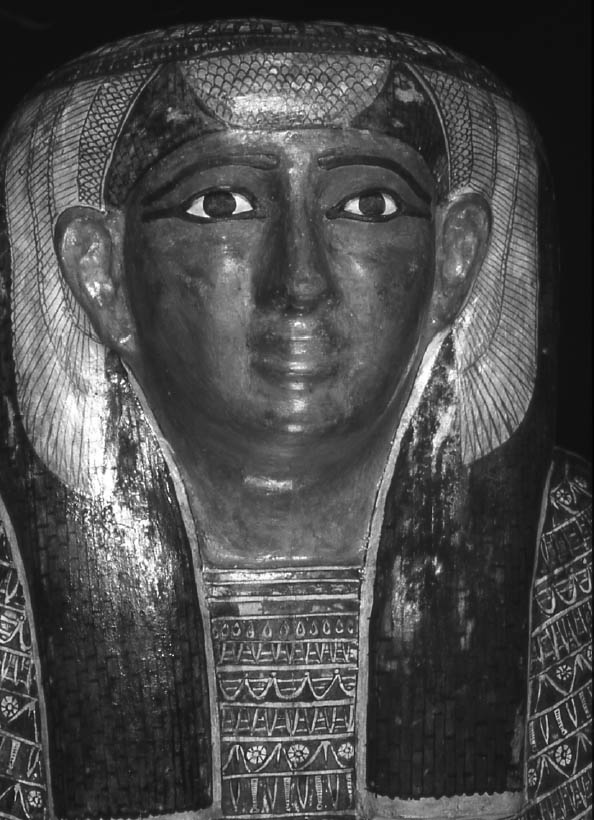PRIOR REPAIRS: WHEN SHOULD THEY BE PRESERVED?JEAN D. PORTELL
6 RE-TREATMENTS THAT ARE TECHNICALLY CONFUSINGWhen an object has been treated more than once, sometimes the repairs applied at different times are difficult to distinguish. Technical analysis of each applied material may be required in order to determine whether it is appropriate—or even possible—to remove any of them. (In the case of works created with modern electronic media, when documentation is lacking it may be impossible ever to distinguish imposed alterations. See sec. 7, below.) 6.1 AN ISLAMIC EWERSometimes an old restoration is so skillful that it clouds an understanding of the object's true condition, which only becomes apparent upon re-treatment. Conservator Stephen P. Koob discovered this effect while working on a Seljuk luster-glazed ceramic ewer of the late 12th century or early 13th
Koob states in his article about this repair that he and the curator decided to reuse the restoration fragments from the old repair in his re-treatment of the ewer, primarily because “the replacement fragments are well-fired, stable and an excellent match to the original,” but also because reusing them was economical (Koob 1999, 163). There is a third reason to retain these beautifully manufactured fills: they exemplify excellence in ceramic restoration—or deceit!—in a past era. Hence a “joint curatorial/conservation label has been proposed to present the viewer with an understanding of the original and the restoration” (Koob 1999, 164). 6.2 THE CARLOS MUSEUM'S EGYPTIAN COFFINSAncient Egyptian artifacts are among the oldest cultural objects that conservators work on, and they may have repairs that date from widely disparate eras. It is useful to read descriptions of treatment materials and techniques applied in the past that have been observed by modern conservators (Jaeschke and Jaeschke 1988; Norman 1988).
If components of coffins were reused later, or old repairs were modified with newer materials, it becomes difficult to distinguish among the various interventions. Conservators and curators at the Michael C. Carlos Museum of Emory University have been working on a multiyear cooperative effort to conserve some Egyptian coffins (Stein et al. 2002). These coffins had received many modern repairs and restorations during the approximately 150 years that they were part of another collection before the Carlos Museum acquired them in 1999. Structures had been reinforced, losses (both structural and superficial) filled, and restorations added. The coffins had also suffered fire and water damage. As the examination and treatment at the Carlos Museum advanced, traces of ancient damages and repairs also became evident. On a set of two nesting coffins that were built and decorated in the 25th dynasty 760–656 B.C. for the female mummy of Iawttavesheret, modern large yellow eyes made of plaster had been affixed to the
The Carlos Museum team also found evidence of what they believe are ancient repairs and alterations due to reuse of a coffin for the funeral of another person. The lid of a coffin originally made in the 21st dynasty 1075–945 B.C. for a woman named Tanakhtanettahat appears to have been reused in antiquity (accession no. 1999.1.17C). A cracked area across the lower legs seems to have broken and been repaired before the coffin was reused for another mummy. This ancient repair has now been documented and preserved. During this process it was also decided to remove (and save) isolated areas of the extensive ancient overpaint, so that viewers could see that beneath it there is still well-preserved, delicately painted original decoration (Stein et al. 2002).
Work on these coffins has been technically complex. For example, conservator Ren�e Stein explained (2002) that it has not been possible to fully According to Stein, it may be impossible to selectively reverse some kinds of prior treatments. Even if a modern oil were identified on one of the coffins, it would be difficult to remove if the coating had penetrated a porous or chemically similar original layer beneath (Stein 2002). In such cases, the author of this article believes that maybe the best one can do is use the clues provided by analyzed samples to create modified digital photographs suggesting how such artifacts might have looked after the ancient treatment and before modern interventions. |



